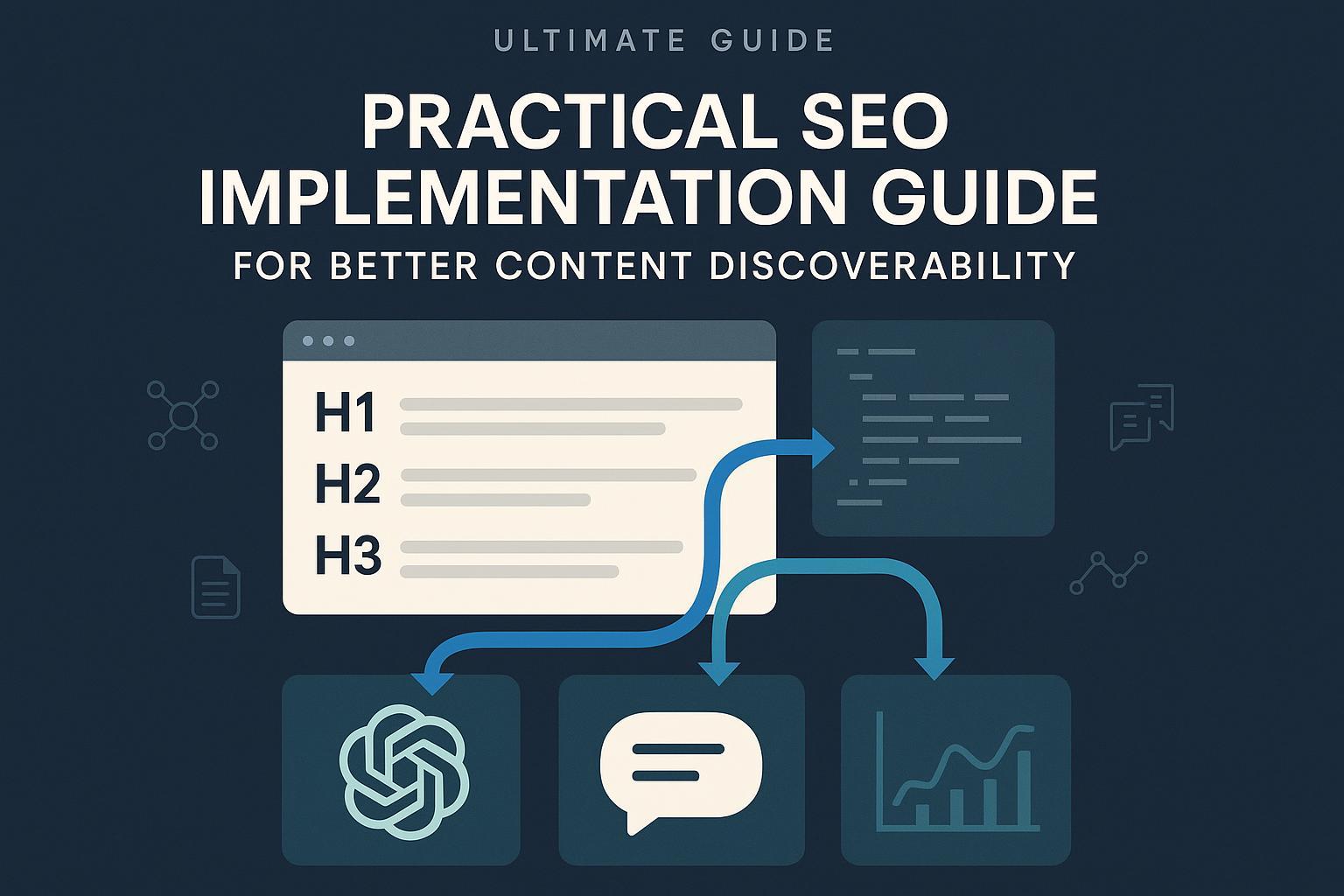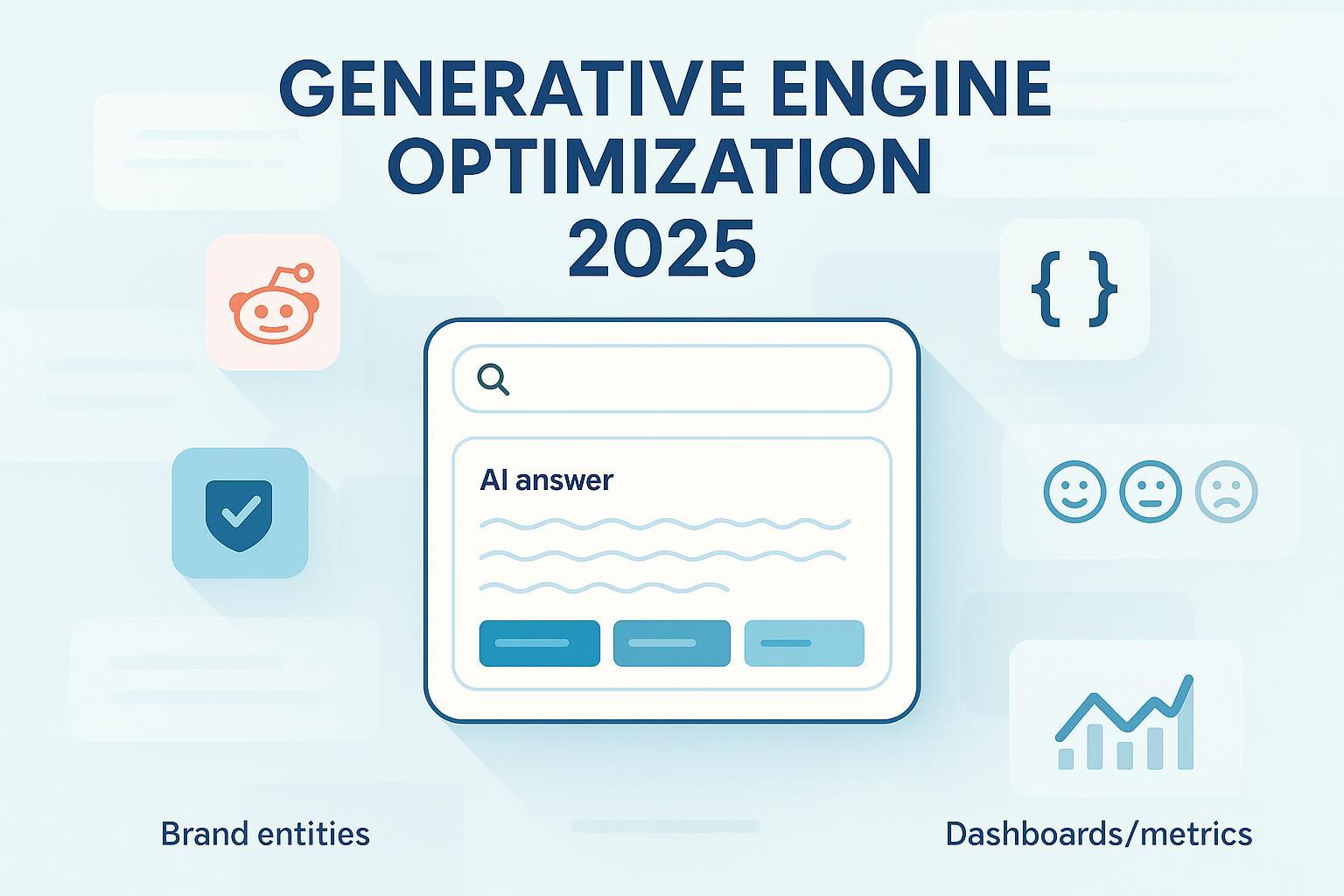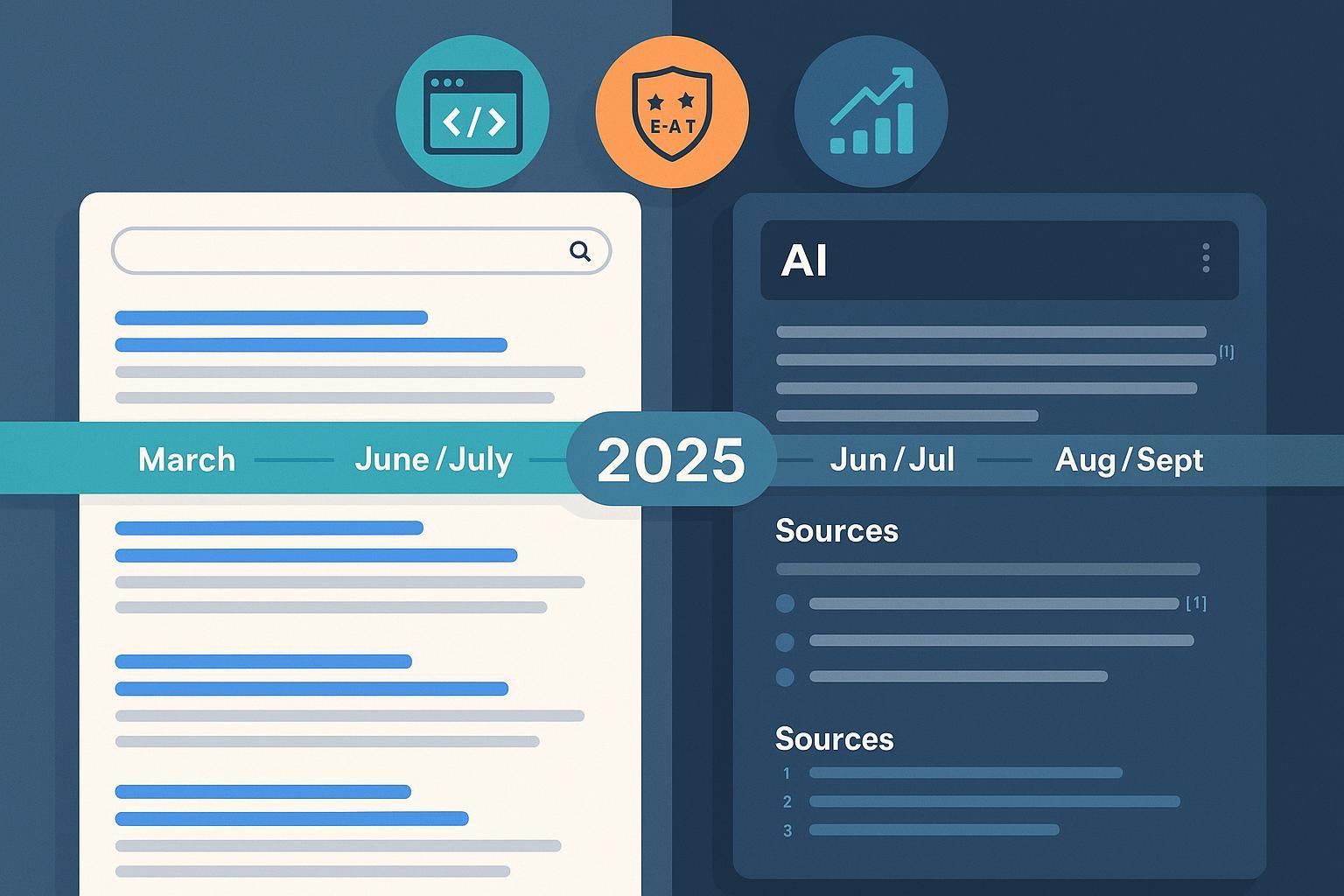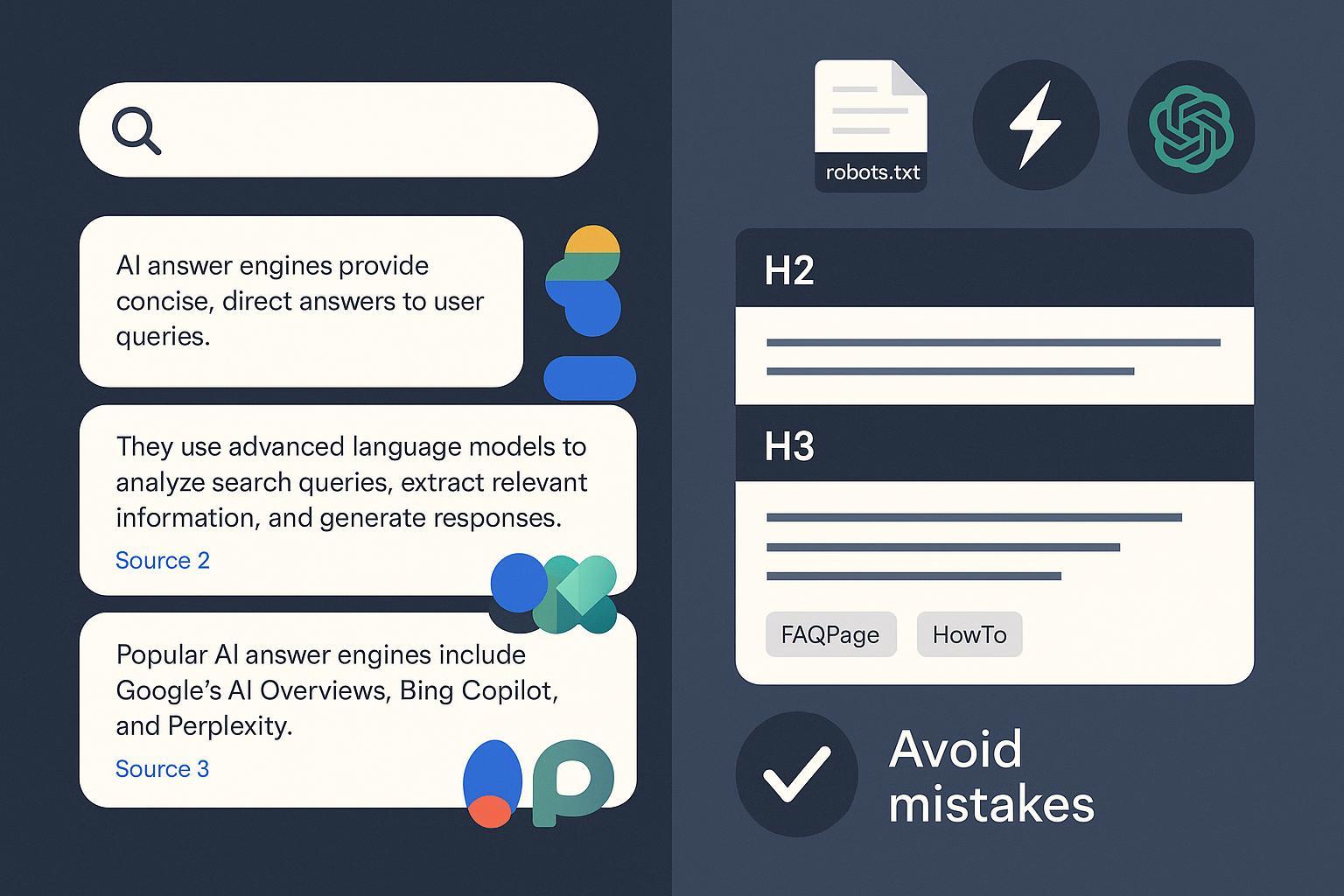Practical GEO Implementation Ultimate Guide for Content Discoverability
Unlock better content discoverability with this complete GEO implementation guide. Learn proven strategies for ChatGPT, Perplexity, and Google AI Overviews. Start optimizing now!


If your organic traffic is drifting from classic SERPs to AI answers, you’re not alone. Generative Engine Optimization (GEO) helps your content get discovered, trusted, and cited inside AI-generated results—across ChatGPT, Perplexity, and Google AI Overviews. This practical guide shows you exactly how to structure content, implement technical signals, and run repeatable tests so you can earn more citations and increase your brand’s visibility where users actually get answers today.
GEO in one page
- Plain definition: GEO is the practice of structuring and signaling your content so generative engines can discover it, understand it, and confidently cite it within synthesized answers.
- Why it’s different from SEO/AEO: SEO optimizes for rankings in SERPs; AEO (Answer Engine Optimization) formats content for direct answers and voice. GEO focuses on being cited and accurately represented by AI systems that summarize multiple sources.
- For a neutral overview of the discipline (2024–2025), see the concise explanations in the Search Engine Land GEO definition (2024) and the methodical breakdown in Backlinko’s GEO guide (2025).
How generative engines choose sources (what we know in 2024–2025)
-
Google AI Overviews
- Eligibility starts with being in Google’s index and meeting overall search quality expectations. Google’s documentation explains how websites can appear in AI features and emphasizes the same fundamentals (indexability, helpful content, technical hygiene). See the official guidance in Google Search Central’s AI features documentation (2025). Google’s product team also notes that AI Overviews blend multiple high-quality sources and provide links for verification, per the Google product blog announcement (2024).
-
ChatGPT (OpenAI)
- ChatGPT can display citations in various modes, but OpenAI hasn’t published a step-by-step playbook for how sources are selected. Treat it as evolving and test-driven. Practitioner research shows referral patterns are inconsistent, so plan for variability and measure outcomes; see the 2024 analysis in Seer Interactive’s report on AI referrals.
-
Perplexity
- Perplexity is source-forward and displays citations prominently, but transparency about crawling/indexing behavior is limited. For practical differences vs. ChatGPT’s experience, see the SE Ranking comparison (2025). Ongoing legal filings highlight crawler-policy controversies, so rely on monitoring and bot management beyond robots.txt when needed; for context, review the Britannica v. Perplexity complaint PDF (2025).
The bottom line: follow the official quality/indexability fundamentals, structure content for passage-level extraction and verifiability, and validate with platform-specific tests rather than assumptions.
Implementation foundations (build these before platform-specific tweaks)
1) Passage-level content engineering
Think in passages, not just pages. You want any single section to stand on its own when extracted by an LLM.
- Lead with a direct answer (<50 words), then elaborate. Use crisp H2/H3 that mirror real queries, followed by steps, comparisons, and FAQs.
- Keep paragraphs tight and facts citeable. Where you rely on external data, attribute to authoritative sources with concise, descriptive anchors.
- Include adjacent follow-ups (“How long does it take?”, “What’s the difference vs. X?”) on the same URL to capture more conversational variants.
For a tactical overview of this approach, see the practical tips summarized in Search Engine Land’s actionable GEO tactics (2025).
2) Structured data (schema) as an understanding aid
Structured data won’t guarantee inclusion in AI Overviews, but it can help search engines understand your entities and page purpose. Implement only what’s visible and accurate.
- Useful types: Article/BlogPosting, Organization, Person, Product, FAQPage (cautioned), HowTo (cautioned), BreadcrumbList, VideoObject, and WebSite. See Google’s Structured data overview (living docs) and the Search Gallery.
- Context on FAQ/HowTo: Google reduced/deprecated these rich results starting in 2023–2024; they still help with understanding but are not a direct AI Overview switch. Validate in the Rich Results Test.
Example JSON-LD starter (tailor fields to your page):
{
"@context": "https://schema.org",
"@type": "Article",
"headline": "Practical GEO Implementation Guide for Better Content Discoverability",
"description": "A practitioner’s manual for structuring, signaling, and measuring content so it’s cited by AI systems.",
"author": {
"@type": "Person",
"name": "Your Name"
},
"publisher": {
"@type": "Organization",
"name": "Your Company",
"logo": {
"@type": "ImageObject",
"url": "https://example.com/logo.png"
}
},
"mainEntityOfPage": {
"@type": "WebPage",
"@id": "https://example.com/geo-implementation-guide"
},
"articleSection": [
"Passage-level content engineering",
"Structured data",
"Crawler controls",
"Platform-specific playbooks",
"Measurement & KPIs"
]
}
3) Technical SEO hygiene still matters
- Indexation & internal linking: Ensure each important URL is discoverable and canonicalized, with logical internal links and sitemaps.
- Performance & accessibility: Fast, mobile-friendly pages with semantic HTML, proper headings, transcripts, and alt text.
- Stable anchors: Use clean, predictable anchors (e.g., #definition, #steps) that are deep-linkable—this often helps when AI systems reference a specific section.
4) Crawler/user-agent controls (be intentional)
- OpenAI crawlers: OpenAI publishes crawler resources and IP lists you can reference when configuring robots.txt or WAF rules. See the OpenAI crawlers overview (living docs), plus JSON IP ranges for OAI-SearchBot and ChatGPT-User. Re-check these pages before deployment as they can change.
- Anthropic and others: Public, consolidated UA documentation can be sparse. Use robots.txt plus WAF/bot management if you need strict enforcement.
- Perplexity: Given transparency questions, treat robots alone as insufficient; pair with monitoring.
Example robots.txt patterns (always validate in your environment):
# Allow OpenAI search bot
User-agent: OAI-SearchBot
Allow: /
# Disallow OpenAI search bot
# User-agent: OAI-SearchBot
# Disallow: /
# Default allow for others
User-agent: *
Allow: /
Note: Patterns vary; confirm current user-agent names and policies before relying on them.
Platform-specific playbooks
The biggest gains often come from matching your content to each platform’s behavior. Below are compact, testable playbooks.
A) Google AI Overviews (AIO)
What to prioritize
- Eligibility and indexing first: If you’re not in the index, you cannot be cited—this is explicit in Google’s AI features documentation (2025).
- Answer-first modules: Lead with a crisp definition or recommendation, followed by steps and a compact pros/cons or comparison table.
- E-E-A-T signals: Author bios with credentials, unique first-hand insights, and transparent sourcing. For a research framing of authority’s impact on outcomes, see the 2025 perspective in First Page Sage’s ranking factors research.
- Structured data as a helper: Use JSON-LD that matches visible content. Don’t expect schema to “force” inclusion; it’s an understanding aid.
Micro test (2–4 weeks)
- Baseline: Capture which of your targets currently appear or are cited in AIO for 10–20 prompts.
- Implement: Rework two priority pages using answer-first structure, inject reputable citations, and tighten entity clarity (Organization, Person).
- Re-audit: Re-run the same prompts weekly for 4 weeks; log whether AIO now includes your page as a cited source and note which passage seems to be referenced.
B) ChatGPT
What to prioritize
- Quotable, compact definitions and procedures. Keep your most important claims tightly sourced to primary or official materials.
- Anticipate follow-ups on the same page: examples, comparisons, FAQs.
- Expect variability: OpenAI hasn’t published a public rubric for source selection; treat this as a test-and-measure surface (see 2024 referral variability in Seer Interactive’s analysis).
Micro test (2–4 weeks)
- Baseline: For 10–15 prompts, record whether your pages are cited and capture the exact phrasing ChatGPT uses.
- Implement: Add a 40–60 word answer box, a numbered how-to, and a brief comparison table to two pages. Add 2–3 authoritative citations.
- Re-audit: Weekly, issue the same prompts. Note any new citations or more accurate paraphrasing of your content.
C) Perplexity
What to prioritize
- Verifiability above all: Short, well-sourced facts; link to official docs and primary sources wherever possible. Perplexity foregrounds citations.
- Design for conversational depth: Include adjacent FAQs (“Is it different in enterprise contexts?” “What changes after 2024 updates?”) on the same URL so Perplexity can expand easily.
- Monitor crawling/indexing behavior pragmatically in your logs; pair robots.txt with WAF if you enforce limits. For broad context on crawler transparency concerns, see the Britannica v. Perplexity complaint (2025).
Micro test (2–4 weeks)
- Baseline: Run 10 prompts that your audience would ask; record whether Perplexity cites your URLs and which sections are referenced.
- Implement: Tighten summary blocks (<=80 words) and add 2–3 primary-source citations per section.
- Re-audit: Track week-over-week changes in citation frequency and the specific passages quoted.
Measurement & KPIs (make GEO provable)
What you measure
- AI-specific visibility metrics
- Citation frequency: How often your pages are cited/linked in AI answers per platform.
- Passage coverage: Which sections are summarized or quoted.
- Brand accuracy/sentiment: Whether the description of your brand is factual and favorable.
- Outcome metrics
- Assisted conversions from AI-referred visits, qualified demo requests, or organic-assisted revenue.
- Changes in cost per acquisition when top-of-funnel quality improves.
How to measure in practice
- Create a prompt-and-citation log. Track prompt theme, platform, date, cited URLs, and any sentiment/accuracy notes.
- Re-run the same prompt set weekly after changes (2–4 weeks) and annotate what you changed on the site.
- Segment by content type (definitions, how-tos, comparisons) to see which formats attract the most citations.
A neutral tool example
- You can automate parts of this workflow with Geneo, which tracks cross-platform mentions and sentiment in AI answers. Disclosure: Geneo is our product.
- To see how query-level tracking looks in the wild, review these live examples that show how answers and citations vary by engine over time: a tourism query like vacation rental homes in Caye Caulker or an adjacent intent such as an authentic Belizean island vacation experience.
Parity-based alternatives
- Manual logging: Use a spreadsheet to record prompts, dates, citations, and sentiment; add screenshots for auditing.
- General analytics + link tracking: Watch for AI-attributed referral traffic (when present) and annotate shifts. Keep in mind that tracking parameters may appear or not, and behavior can change by surface.
SOP checklists and templates
Use these as working templates. Adapt per vertical.
Content structuring checklist (per page)
- H1: Clear promise of scope; avoid vague titles.
- Intro: A 40–60 word direct answer. Then expand with steps, comparisons, and FAQs.
- Headings: H2/H3 mirror real questions your audience asks.
- Facts: Short, citeable statements with 1–2 authoritative sources.
- Tables/lists: Where comparisons or steps are clearer in a structured format.
- FAQs: Anticipate follow-ups and edge cases.
- Entities: Clear Organization, Person, Product bios (with credentials where relevant).
- Links: Favor primary/official sources for critical claims.
Schema starter checklist
- Article/BlogPosting with clear headline and mainEntityOfPage
- Organization/Person entities for publisher and author
- BreadcrumbList for navigation clarity
- Optional: FAQPage/HowTo (only when visible and accurate on-page)
- Validate in Google’s Rich Results Test and keep structured data aligned with visible content
Robots and crawler controls mini-SOP
- Confirm current UA names/policies (e.g., OpenAI’s OAI-SearchBot, ChatGPT-User) in the OpenAI crawler overview (living docs) and JSON lists.
- Decide per section or directory if you want to allow/deny specific bots.
- Enforce with WAF/bot tools if strict control is required; expect potential UA spoofing attempts.
- Log requests and compare to your AI visibility outcomes (do changes in access correlate with citation frequency?).
Prompt-and-citation log template (concept)
Columns: Date | Platform (ChatGPT/Perplexity/AIO) | Prompt | Cited URLs | Passage/Section | Sentiment/Accuracy Note | Screenshot link | Page changes since last audit
Troubleshooting and edge cases
- “We’re not cited anywhere.” Baseline first: Are you in Google’s index? Is your page clearly the best short answer with authoritative citations? If yes, iterate structure and add adjacent FAQs.
- “Schema didn’t help.” That’s expected—schema aids understanding but doesn’t guarantee AI Overview inclusion. Focus on answer-first clarity and authority signals backed by sources.
- “Tracking is inconsistent.” Some AI surfaces add or omit referral parameters. Use screenshots and consistent prompt sets to create a reliable time series; see 2024 observations in the Seer Interactive referral analysis.
- “Our niche is highly regulated.” Emphasize expert authorship, citations to official bodies, and conservative claims. Keep a change log mapping edits to any shifts in AI citations.
- “Community influence?” High-signal communities sometimes seed reputable references that LLMs notice. For tactics, see this walkthrough on participating in Reddit communities to influence AI citations.
30-day GEO plan (repeatable)
Week 1: Baseline
- Pick 15–30 prompts that map to your buyer journey across three platforms.
- Record citations, sentiment, and which passages are referenced. Note missing coverage.
Week 2: Implement changes on 3–5 priority pages
- Add a crisp answer box, step-by-step lists, and a brief comparison table.
- Tighten entity clarity, author credentials, and on-page citations to primary/official sources.
- Implement or validate JSON-LD for Article/Organization/Person.
Week 3: Strengthen authority & distribution
- Pitch expert commentary to reputable publications and practitioner blogs.
- Participate in credible communities with substantive contributions (not link drops).
- Ensure clean internal linking and performance.
Week 4: Re-audit and report
- Re-run prompts; log changes in citation frequency and accuracy of representation.
- Tie visibility to outcomes (assisted conversions, pipeline, demo requests).
- Decide next iteration: double down on pages that showed movement; replicate the winning format.
References and further reading
- Official eligibility and guidance for appearing in AI Search features are outlined in Google Search Central’s AI features documentation (2025). For product framing, see the Google product blog announcement (2024).
- Practitioner definitions and step-by-step framing of GEO are covered by the Search Engine Land GEO definition (2024) and the detailed Backlinko GEO guide (2025).
- Technical strategies emphasizing passage-level optimization and measurement loops are well summarized in Go Fish Digital’s GEO explainer (2025) and its strategy follow-on.
- Authority and expert-led content remain core success drivers; see First Page Sage’s ranking factors perspective (2025).
- For crawler/user-agent controls, review the OpenAI crawlers overview (living docs), the OAI-SearchBot IP ranges, and ChatGPT-User ranges. For practical differences between generative engines, compare the SE Ranking overview of ChatGPT vs. Perplexity (2025) and consider ongoing industry context like the Britannica v. Perplexity complaint (2025).
Final notes
GEO is not a hack; it’s disciplined content engineering plus measurement. If you build answer-first pages with verifiable facts, keep your technical house in order, and run tight feedback loops, you’ll steadily increase how often AI systems discover and cite your work. Iterate in 2–4 week cycles, and let the data guide what you do next.




